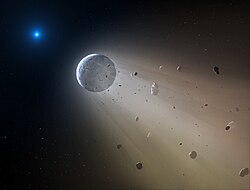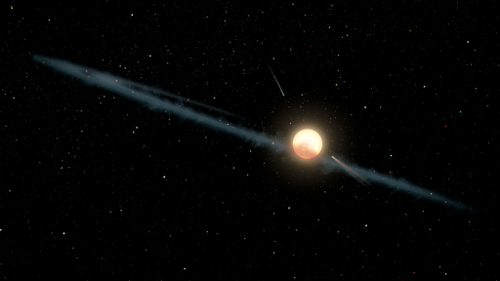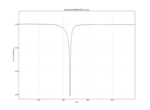Usuari:Albert SN/Planeta pertorbat

En astronomia, un planeta destruït[1][2] és un planeta o exoplaneta o, potser a una escala una mica més petita, un objecte de massa planetària, planetesimal, satèl·lit natural, satèl·lit extrasolar o asteroide que ha estat alterat o destruït per un objecte proper o que passa, com ara una estrella.[1][2] La necroplanetologia és l'estudi relacionat d'aquest procés.[3][4] No obstant això, el resultat d'aquesta alteració pot ser la producció de quantitats excessives de gas relacionat, pols i restes,[5] que eventualment poden envoltar l'estrella mare en forma de disc circumestel·lar o disc de fragments. Com a conseqüència, el camp de deixalles en òrbita pot ser un "anell de pols irregular", que provoca fluctuacions erràtiques de la llum en la lluminositat aparent de l'estrella mare, com podria haver estat responsable de les corbes de llum estranyament parpellejant associades a la llum de les estrelles observades a partir de determinades estrelles variables, com ara l`Estrella de Tabby (KIC 8462852), RZ Piscium i WD 1145+017.[3][4] Quantitats excessives de radiació infraroges poden detectar a partir d'aquestes estrelles,[6] proves suggerents en si mateixes que la pols i les deixalles poden estar orbitant les estrelles.[5][7][8][9]
Exemples[modifica]
Planetes[modifica]
Alguns exemples de planetes, o les seves restes relacionades, considerats com un planeta destruït, o part d'aquest planeta, inclouen: 'Oumuamua[10] i WD 1145+017 b, així com asteroides,[11] Júpiters calents[12] i els que són planetes hipotètics, com el cinquè planeta, el Faetó, el planeta V i Teia.
Estrelles[modifica]
Alguns exemples d'estrelles mare que es considera que han destruït un planeta inclouen: EPIC 204278916, estrella de Tabby (KIC 8462852), PDS 110, RZ Piscium, WD 1145+017 i 47 Ursae Majoris.

Corba de llum de l'estrella de Tabby[modifica]
L'estrella de Tabby (KIC 8462852) és una estrella de seqüència principal de tipus F que presenta fluctuacions de llum inusuals, inclosa una disminució de la brillantor de fins a un 22%.[13] S'han proposat diverses hipòtesis per explicar aquests canvis irregulars, però cap fins ara no explica completament tots els aspectes de la corba. Una explicació és que un "anell desigual de pols" orbita l'estrella de Tabby.[14][15] No obstant això, el setembre de 2019, els astrònoms van informar que els enfosquiments observats de l'estrella de Tabby podrien haver estat produïts per fragments derivats de la interrupció d'una exolluna òrfena.[16][17]
-
Totes les dades de la corba de llum − Des de desembre de 2009 fins a maig de 2013, dies d'escanejos del 0066 al 1587 (Kepler)
-
5 de març de 2011 - dia 792
Caiguda màxima del 15% ("Kepler") -
28 de febrer de 2013 - dia 1519
Caiguda màxima del 22% ("Kepler") -
17 d'abril de 2013 - dia 1568
Caiguda màxima del 8% ("Kepler") -
Corba de llum entre el 10 d'octubre de 2019 i l'11 de gener de 2020 (HAO)[22]
Referències[modifica]
- ↑ 1,0 1,1 News Staff. «Young Star RZ Piscium is 'Eating' Its Own Planets, Astronomers Say» (en anglès). Sci-News.com, 22-12-2017. [Consulta: 31 juliol 2023].
- ↑ 2,0 2,1 Fryling, Kevin. «IU astronomer's analysis helps discover that a star in the constellation Pisces is a 'planet-eater'» (en anglès). Indiana University, 21-12-2017. [Consulta: 31 juliol 2023].
- ↑ 3,0 3,1 Starr, Michelle «Necroplanetology: The Strangest Field of Astronomy You've Never Heard Of» (en anglès). ScienceAlert.com, 28-03-2020 [Consulta: 31 juliol 2023].
- ↑ 4,0 4,1 Duvvuri, Girish M.; Redfield, Seth; Veras, Dimitri «Necroplanetology: Simulating the Tidal Disruption of Differentiated Planetary Material Orbiting WD 1145+017» (en anglès). The Astrophysical Journal, 893, 2, 18-03-2020, pàg. 166. arXiv: 2003.08410. Bibcode: 2020ApJ...893..166D. DOI: 10.3847/1538-4357/ab7fa0.
- ↑ 5,0 5,1 Punzi, K. M.; Kastner, J. H.; Melis, C.; Zuckerman, B.; Pilachowski, C.; Gingerich, L.; Knapp, T. «Is the Young Star RZ Piscium Consuming Its Own (Planetary) Offspring?» (en anglès). The Astronomical Journal, 155, 1, 21-12-2017, pàg. 33. arXiv: 1712.08962. Bibcode: 2018AJ....155...33P. DOI: 10.3847/1538-3881/aa9524.
- ↑ Farihi, J.; Jura, M.; Zuckerman, B. «Infrared Signatures of Disrupted Minor Planets at White Dwarfs». The Astrophysical Journal, vol. 694, 2, 10-03-2009, pàg. 805–819. arXiv: 0901.0973. Bibcode: 2009ApJ...694..805F. DOI: 10.1088/0004-637X/694/2/805.
- ↑ Landau, Elizabeth. «Mysterious Dimming of Tabby's Star May Be Caused by Dust» (en anglès). NASA, 04-10-2017. [Consulta: 31 juliol 2023].
- ↑ Meng, Huan Y.A.; Rieke, George; Dubois, Franky; Kennedy, Grant; Marengo, Massimo; Siegel, Michael; Su, Kate; Trueba, Nicolas; Wyatt, Mark; Boyajian, Tabetha; Lisse, C. M.; Logie, Ludwig; Rau, Steve; Vanaverbeke, Sigfried «Extinction and the Dimming of KIC 8462852» (en anglès). The Astrophysical Journal, 847, 2, 03-10-2017, pàg. 131. arXiv: 1708.07556. Bibcode: 2017ApJ...847..131M. DOI: 10.3847/1538-4357/aa899c.
- ↑ Tabor, Abby. «The scientific quest to explain Kepler's most enigmatic find» (en anglès). Phys.org, 05-10-2017. [Consulta: 31 juliol 2023].
- ↑ Ćuk, Matija «1I/ʻOumuamua as a Tidal Disruption Fragment From a Binary Star System» (en anglès). The Astrophysical Journal, 852, 1, 2017, pàg. L15. arXiv: 1712.01823. Bibcode: 2018ApJ...852L..15C. DOI: 10.3847/2041-8213/aaa3db.
- ↑ Soter, Steven «What is a Planet?» (en anglès). The Astronomical Journal, 132, 6, 2006, pàg. 2513–2519. arXiv: astro-ph/0608359. Bibcode: 2006AJ....132.2513S. DOI: 10.1086/508861.
- ↑ Nayakshin, Sergei «Hot Super Earths: disrupted young jupiters?» (en anglès). Monthly Notices of the Royal Astronomical Society, 416, 4, 20-09-2011, pàg. 2974–2980. arXiv: 1103.1846. Bibcode: 2011MNRAS.416.2974N. DOI: 10.1111/j.1365-2966.2011.19246.x [Consulta: 31 juliol 2023].
- ↑ Boyajian, T. S.; LaCourse, D. M.; Rappaport, S. A.; Fabrycky, D.; Fischer, D. A.; Gandolfi, D.; Kennedy, G. M.; Korhonen, H.; Liu, M. C. «Planet Hunters IX. KIC 8462852 – where's the flux?» (en anglès). Monthly Notices of the Royal Astronomical Society, 457, 4, 27-01-2016, pàg. 3988–4004. arXiv: 1509.03622. Bibcode: 2016MNRAS.457.3988B. DOI: 10.1093/mnras/stw218. ISSN: 0035-8711.
- ↑ «Mysterious Dimming of Tabby's Star May Be Caused by Dust» (en anglès). NASA/JPL. [Consulta: 31 juliol 2023].
- ↑ Boyajian, Tabetha S.; Alonso, Roi; Ammerman, Alex; Armstrong, David; Ramos, A. Asensio; Barkaoui, K.; Beatty, Thomas G.; Benkhaldoun, Z.; Benni, Paul «The nom Post-Kepler Brightness Dips of KIC 8462852» (en anglès). The Astrophysical Journal, 853, 1, 19-01-2018, pàg. L8. arXiv: 1801.00732. Bibcode: 2018ApJ...853L...8B. DOI: 10.3847/2041-8213/aaa405. ISSN: 2041-8213.
- ↑ Columbia University «New observations help explain the dimming of Tabby's Star» (en anglès). Phys.org, 16-09-2019 [Consulta: 31 juliol 2023].
- ↑ Marinez, Miquel; Stone, Nicholas C.; Metzger, Brian D. «Orphaned Exomoons: Tidal Detachment and Evaporation Following an Exoplanet-Star Collision» (en anglès). Monthly Notices of the Royal Astronomical Society, 489, 4, 05-09-2019, pàg. 5119–5135. arXiv: 1906.08788. Bibcode: 2019MNRAS.489.5119M. DOI: 10.1093/mnras/stz2464.
- ↑ Gary, Bruce L. «Hereford Arizona Observatory photometry observations of KIC 8462852». BruceGary.net, 14-11-2017. [Consulta: 24 December 2017].
- ↑ Gary, Bruce L. «Hereford Arizona Observatory photometry observations of KIC 8462852 between 2 May and 4 October 2017». BruceGary.net, 04-10-2017. Arxivat de l'original el 4 October 2017. [Consulta: 23 December 2017]. «Note: g'-band and r'-band dip depths (and shapes) may differ, with g'-band being more sensitive to dust cloud scattering due to its shorter wavelength (0.47 vs. 0.62 micron). For a reasonable particle size distribution (e.g., Hanson, 0.2 micron) the extinction cross section ratio would produce a depth at r'-band that is 0.57 x depth at g'-band. If g'-band depth is 0.3 %, for example, depth at r'-band could be 0.17 %. The "Tabby Team" measurements (Fig. 3) at r'-band are compatible with that small dip depth. Incidentally, none of these shapes resemble exo-comet tail transits (as described by Rappaport et al, 2017 link); so the mystery of what's producing these week-timescale dips continues! Actually, long oval shapes are known to produce V-shaped dips (think of rings with a high inclination).»
- ↑ Gary, Bruce L. «Hereford Arizona Observatory photometry observations of KIC 8462852 between 2 May and 31 December 2017». BruceGary.net, 01-01-2018. Arxivat de l'original el 2 January 2018. [Consulta: 1r gener 2018].
- ↑ Gary, Bruce L. «Hereford Arizona Observatory photometry observations of KIC 8462852 between 2 May 2017 and 4 May 2018». BruceGary.net, 04-05-2018. Arxivat de l'original el 5 May 2018. [Consulta: 5 maig 2018].
- ↑ Gary, Bruce. «KIC 8462852 Hereford Arizona Observatory Photometry Observations #9», 11-01-2020. Arxivat de l'original el 5 April 2020. [Consulta: 5 abril 2020].
Lectures addicionals[modifica]
- Ernst, Wallace Gary. Columbia University Press. The Dynamic Planet (en anglès), 1990, p. 18. ISBN 978-0-231-07231-1.
- Woolfson, Michael M. CRC Press. The Origin and Evolution of the Solar System (en anglès), 2000. ISBN 978-1-4200-3335-9.
Vegeu també[modifica]
- Antics planetes nans
- Cinturó d'asteroides
- BD+20°307
- Formació i evolució del sistema solar
- Hipòtesi del gran impacte
- Medi interestel·lar
- Llista d'estrelles que tenen períodes d'enfosquiment poc habituals
- Hipòtesi nebular
- Planetesimal
- Disc protoplanetari
- Força de marea
- WD 0145+234 (estrella que altera un exoasteroide)
Enllaços externs[modifica]
- NASA – WD 1145+017 b a The Extrasolar Planets Encyclopaedia. (anglès)
 Video (13:46) − "Tabby's Star" a YouTube, una presentació de Tabetha S. Boyajian. (anglès)
Video (13:46) − "Tabby's Star" a YouTube, una presentació de Tabetha S. Boyajian. (anglès) Video (31:00) − "Tabby's Star" a YouTube, una presentació d'Isaac Arthur. (anglès)
Video (31:00) − "Tabby's Star" a YouTube, una presentació d'Isaac Arthur. (anglès) Video (01:00) − RZ Piscium a YouTube, estrella amb fluctuacions de llum inusuals (21 de desembre de 2017). (anglès)
Video (01:00) − RZ Piscium a YouTube, estrella amb fluctuacions de llum inusuals (21 de desembre de 2017). (anglès)






![Corba de llum d'un any − fins al 4 de maig de 2018 (HAO[18][19][20][21])](http://upload.wikimedia.org/wikipedia/commons/thumb/5/5d/KIC_8462852_Daily_Normalized_Flux_by_Bruce_Gary%2C_20170502-20180504.png/150px-KIC_8462852_Daily_Normalized_Flux_by_Bruce_Gary%2C_20170502-20180504.png)
![Corba de llum entre el 10 d'octubre de 2019 i l'11 de gener de 2020 (HAO)[22]](http://upload.wikimedia.org/wikipedia/commons/thumb/8/8f/KIC_8462852_October-December_2019_Gary.jpg/150px-KIC_8462852_October-December_2019_Gary.jpg)